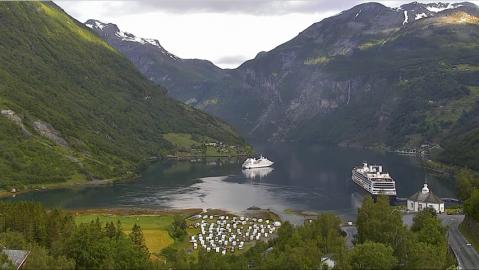Three hundred kilometers north of the Polar Circle, on the Lofoten Island of Vestvågøya, a farmer discovered the remains of the largest Viking Era longhouse ever uncovered. Archaeologists later uncovered remains of boathouses used by Viking Era chieftans to build the boats that would take them all across Europe to sell their fish.
Abandoned around around 950 AD, today the reconstructed longhouse (the chieftain’s house) measures 83 meters (272 ft) long and 9.5 meters (31 ft) wide. Inside, the Lofotr Viking Museum hosts nightly Viking feasts and demonstrations of tools of the era: the vertical loom, a bowl lathe, a shaving horse for basket weaving and basic tools for natural tanning of leather.
The boathouses and Viking ships of the era have been reconstructed in accordance of the technology of the time: the iron nails that allowed for the building of “way bigger ships”. This allowed for a more flexible ship that would twist and turn in big waves and allowed for long distance travel (even to the Americas) reaching speeds of 20 knots with good weather using woolen sails and open hulls.
The Lofoten Islands were rich in marine life and during the winter months they caught abundant amounts of cod which they then dried naturally. Despite being located at he 68th parallel north, the same parallel as central Greenland or northern Alaska, thanks to the Gulf Stream, the climate here is much milder.
With winter temperatures averaging around 0˚C and a near constant wind, these are ideal conditions for air drying fish without the need to smoke or salt it. This stockfish was then loaded onto ships and sailed to the rest of Europe.
— Lofotr Viking Museum: https://www.lofotr.no/en/lofotr-vikingmuseum/
On *faircompanies: https://faircompanies.com/videos/viking-longhouse-above-arctic-circle-is-ideal-extreme-weather-dwelling/
Abandoned around around 950 AD, today the reconstructed longhouse (the chieftain’s house) measures 83 meters (272 ft) long and 9.5 meters (31 ft) wide. Inside, the Lofotr Viking Museum hosts nightly Viking feasts and demonstrations of tools of the era: the vertical loom, a bowl lathe, a shaving horse for basket weaving and basic tools for natural tanning of leather.
The boathouses and Viking ships of the era have been reconstructed in accordance of the technology of the time: the iron nails that allowed for the building of “way bigger ships”. This allowed for a more flexible ship that would twist and turn in big waves and allowed for long distance travel (even to the Americas) reaching speeds of 20 knots with good weather using woolen sails and open hulls.
The Lofoten Islands were rich in marine life and during the winter months they caught abundant amounts of cod which they then dried naturally. Despite being located at he 68th parallel north, the same parallel as central Greenland or northern Alaska, thanks to the Gulf Stream, the climate here is much milder.
With winter temperatures averaging around 0˚C and a near constant wind, these are ideal conditions for air drying fish without the need to smoke or salt it. This stockfish was then loaded onto ships and sailed to the rest of Europe.
— Lofotr Viking Museum: https://www.lofotr.no/en/lofotr-vikingmuseum/
On *faircompanies: https://faircompanies.com/videos/viking-longhouse-above-arctic-circle-is-ideal-extreme-weather-dwelling/
- Category
- ATLANTIC ROAD
- Tags
- Viking longhouse, viking ship, reconstructed viking ship
Commenting disabled.









